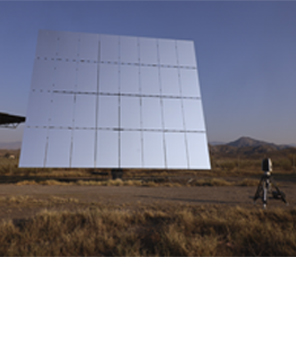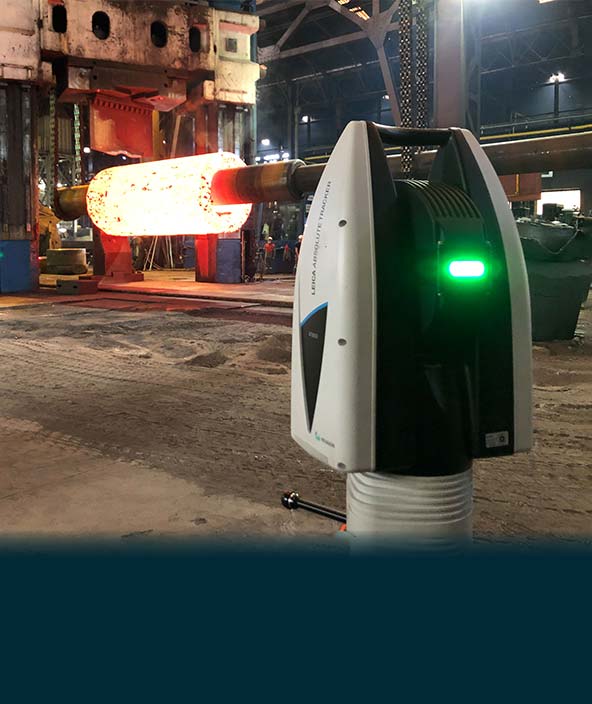La nueva estrategia de escaneo directo mejora la precisión y repetibilidad
Las necesidades específicas de un cliente del sector aeroespacial llevaron al desarrollo de una nueva e innovadora estrategia de medición para el escaneo directo con el Leica Absolute Tracker ATS600

Artículo técnico - Leica Absolute Tracker ATS600, parte 1
Desde el lanzamiento del Leica Absolute Tracker ATS600, la innovadora capacidad de escaneo directo del sistema ha abierto una amplia gama de nuevas aplicaciones de inspección de grado metrológico: mediciones que previamente resultaban imposibles ahora pueden efectuarse con facilidad, lo que permite un mayor control de calidad de productos de mayor escala como nunca antes había sido posible.
 Durante el año 2022, un importante cliente del sector aeroespacial estableció contacto con el equipo de láser tracker de Hexagon ya que estaba interesado en modificar su proceso de medición actual (el cual incluía un proceso de medición con tracker y reflector) por uno de escaneo directo con el ATS600. En su proceso actual, un operario recibía una lista de puntos de la superficie de la pieza y se colocaba un reflector en cada uno de estos puntos para efectuar una medición. Los puntos se registraban solo cuando el reflector alcanzaba la coordenada. Debido al tamaño de la pieza, era necesario un andamio y un equipo de seguridad, el cual debían cambiar de posición varias veces debido al tamaño característico de las piezas que se medían. Se trataba de un proceso que requería mucho tiempo, principal motivo para investigar el cambio al escaneo directo.
Durante el año 2022, un importante cliente del sector aeroespacial estableció contacto con el equipo de láser tracker de Hexagon ya que estaba interesado en modificar su proceso de medición actual (el cual incluía un proceso de medición con tracker y reflector) por uno de escaneo directo con el ATS600. En su proceso actual, un operario recibía una lista de puntos de la superficie de la pieza y se colocaba un reflector en cada uno de estos puntos para efectuar una medición. Los puntos se registraban solo cuando el reflector alcanzaba la coordenada. Debido al tamaño de la pieza, era necesario un andamio y un equipo de seguridad, el cual debían cambiar de posición varias veces debido al tamaño característico de las piezas que se medían. Se trataba de un proceso que requería mucho tiempo, principal motivo para investigar el cambio al escaneo directo.
Sin embargo, a la empresa le preocupaba saber si el funcionamiento del escaneo directo del ATS600 cumpliría con sus especificaciones de tolerancia: Hexagon ha manifestado abiertamente que la facilidad del escaneo directo tiene como contrapartida una menor precisión en comparación con la inspección con reflector . Se programó una serie de pruebas con el equipo local de Hexagon y una unidad de demostración, con el objetivo de demostrar si los resultados de medición sin reflector serían lo suficientemente buenos para cumplir con las tolerancias ajustadas del sector aeroespacial.
Durante la prueba programada, las primeras mediciones efectuadas simultáneamente con un reflector y con escaneo directo no dieron resultados coincidentes. Se pensó que esta variación se debía a la calidad de la superficie, la cual mostraba rayas y marcas como resultado de procesos de fabricación previos. Debido a que el equipo local creía que se trataba de un problema de variabilidad y no de incapacidad para alcanzar el nivel de precisión necesario, se pusieron en contacto con el equipo de expertos de láser tracker de Hexagon con sede en Suiza, donde se diseña y se fabrica la gama Absolute Tracker, para obtener asesoría.
El equipo comenzó con una serie de experimentos, durante los cuales se midió una placa de acero pulido a varias distancias (de 2 a 15 metros) e incidencias (de 0° a 60°) con respecto al ATS600. Inicialmente la placa se midió con un reflector de 1.5” desde cada distancia e incidencia, con 21 puntos tomados y utilizados para ajustar un plano. Las mediciones subsecuentes con escaneo directo mostraron el mismo problema de variabilidad que había detectado el equipo local in situ con el cliente del sector aeroespacial.
 Durante el año 2022, un importante cliente del sector aeroespacial estableció contacto con el equipo de láser tracker de Hexagon ya que estaba interesado en modificar su proceso de medición actual (el cual incluía un proceso de medición con tracker y reflector) por uno de escaneo directo con el ATS600. En su proceso actual, un operario recibía una lista de puntos de la superficie de la pieza y se colocaba un reflector en cada uno de estos puntos para efectuar una medición. Los puntos se registraban solo cuando el reflector alcanzaba la coordenada. Debido al tamaño de la pieza, era necesario un andamio y un equipo de seguridad, el cual debían cambiar de posición varias veces debido al tamaño característico de las piezas que se medían. Se trataba de un proceso que requería mucho tiempo, principal motivo para investigar el cambio al escaneo directo.
Durante el año 2022, un importante cliente del sector aeroespacial estableció contacto con el equipo de láser tracker de Hexagon ya que estaba interesado en modificar su proceso de medición actual (el cual incluía un proceso de medición con tracker y reflector) por uno de escaneo directo con el ATS600. En su proceso actual, un operario recibía una lista de puntos de la superficie de la pieza y se colocaba un reflector en cada uno de estos puntos para efectuar una medición. Los puntos se registraban solo cuando el reflector alcanzaba la coordenada. Debido al tamaño de la pieza, era necesario un andamio y un equipo de seguridad, el cual debían cambiar de posición varias veces debido al tamaño característico de las piezas que se medían. Se trataba de un proceso que requería mucho tiempo, principal motivo para investigar el cambio al escaneo directo.Sin embargo, a la empresa le preocupaba saber si el funcionamiento del escaneo directo del ATS600 cumpliría con sus especificaciones de tolerancia: Hexagon ha manifestado abiertamente que la facilidad del escaneo directo tiene como contrapartida una menor precisión en comparación con la inspección con reflector . Se programó una serie de pruebas con el equipo local de Hexagon y una unidad de demostración, con el objetivo de demostrar si los resultados de medición sin reflector serían lo suficientemente buenos para cumplir con las tolerancias ajustadas del sector aeroespacial.
Durante la prueba programada, las primeras mediciones efectuadas simultáneamente con un reflector y con escaneo directo no dieron resultados coincidentes. Se pensó que esta variación se debía a la calidad de la superficie, la cual mostraba rayas y marcas como resultado de procesos de fabricación previos. Debido a que el equipo local creía que se trataba de un problema de variabilidad y no de incapacidad para alcanzar el nivel de precisión necesario, se pusieron en contacto con el equipo de expertos de láser tracker de Hexagon con sede en Suiza, donde se diseña y se fabrica la gama Absolute Tracker, para obtener asesoría.
El equipo comenzó con una serie de experimentos, durante los cuales se midió una placa de acero pulido a varias distancias (de 2 a 15 metros) e incidencias (de 0° a 60°) con respecto al ATS600. Inicialmente la placa se midió con un reflector de 1.5” desde cada distancia e incidencia, con 21 puntos tomados y utilizados para ajustar un plano. Las mediciones subsecuentes con escaneo directo mostraron el mismo problema de variabilidad que había detectado el equipo local in situ con el cliente del sector aeroespacial.

Figure 1. Un objeto de acero pulido utilizado en las pruebas. (a la izquierda) | Representación de la malla de medición utilizada para crear un valor medio de puntos. (a la derecha)
Después de analizar el problema, el equipo desarrolló una nueva estrategia de medición que ha sido denominada medición de puntos de comparación de superficie.
El concepto incluye tomar una malla de mediciones de puntos con separaciones mínimas y utilizar esos resultados para calcular un valor promedio de coordenadas para el punto central de la malla.
Supongamos que, para un objeto determinado, es necesario medir 100 puntos distintos. Es posible importar las coordenadas de esos puntos al software y alrededor de cada uno se creará automáticamente una malla (pequeña pero densa) de puntos de medición sin reflector. Cuando el usuario pulsa “Measure”, el ATS600 escaneará cada punto en la malla y calculará un valor medio que representa la coordenada deseada. Este proceso elimina los errores gruesos provocados por rayones en el material. El radio recomendado para la malla es de entre 4 y 8 milímetros, con el valor mayor recomendado para distancias de medición mayores conforme el diámetro del rayo láser se incrementa.
Las pruebas exhaustivas efectuadas por los ingenieros de láser tracker de Hexagon han demostrado que esta estrategia puede mejorar la precisión en un factor de dos, con una repetibilidad reducida drásticamente a solo 10 micras. La nueva medición puede implementarse fácilmente por aquellos paquetes de software de metrología que cuentan con una interface con el ATS600; los clientes deben contactar a su representante local de Hexagon si también están interesados en utilizar esta nueva estrategia de medición.
El concepto incluye tomar una malla de mediciones de puntos con separaciones mínimas y utilizar esos resultados para calcular un valor promedio de coordenadas para el punto central de la malla.
Supongamos que, para un objeto determinado, es necesario medir 100 puntos distintos. Es posible importar las coordenadas de esos puntos al software y alrededor de cada uno se creará automáticamente una malla (pequeña pero densa) de puntos de medición sin reflector. Cuando el usuario pulsa “Measure”, el ATS600 escaneará cada punto en la malla y calculará un valor medio que representa la coordenada deseada. Este proceso elimina los errores gruesos provocados por rayones en el material. El radio recomendado para la malla es de entre 4 y 8 milímetros, con el valor mayor recomendado para distancias de medición mayores conforme el diámetro del rayo láser se incrementa.
Mejora de la precisión por un factor de dos, con una repetibilidad drásticamente reducida a solo 10 micras.
El resultado es una nueva estrategia de medición relativamente sencilla que ofrece excelentes resultados de precisión y repetibilidad y simultáneamente proporciona un ahorro de tiempo considerable comparado con la medición con reflector.Las pruebas exhaustivas efectuadas por los ingenieros de láser tracker de Hexagon han demostrado que esta estrategia puede mejorar la precisión en un factor de dos, con una repetibilidad reducida drásticamente a solo 10 micras. La nueva medición puede implementarse fácilmente por aquellos paquetes de software de metrología que cuentan con una interface con el ATS600; los clientes deben contactar a su representante local de Hexagon si también están interesados en utilizar esta nueva estrategia de medición.

Figure 2. Resultados de medición utilizando escaneo directo de punto individual. (a la izquierda) | Resultados utilizando mallas de puntos de comparación de superficies de 0.5 mm x 0.5 mm. (a la derecha)
Con base en estos resultados, la empresa aeroespacial que comenzó la investigación invirtió en tres nuevas unidades ATS600. En comparación con sus actuales flujos de trabajo de configuración y calentamiento, los tiempos de inspección se reducirán de 2.5 horas a solo 45 minutos.
Además, el método de escaneo directo garantiza la seguridad del trabajador ya que deja de ser necesario trabajar en las alturas. Además, la capacidad del ATS600 para efectuar mediciones con y sin reflector le permite continuar ejecutando las rutinas actuales de unión de alas con reflectores, al tiempo que puede cambiar a nuevas rutinas de inspección por escaneo sin contacto sin múltiples configuraciones tecnológicas ni desmontajes.
Además, el método de escaneo directo garantiza la seguridad del trabajador ya que deja de ser necesario trabajar en las alturas. Además, la capacidad del ATS600 para efectuar mediciones con y sin reflector le permite continuar ejecutando las rutinas actuales de unión de alas con reflectores, al tiempo que puede cambiar a nuevas rutinas de inspección por escaneo sin contacto sin múltiples configuraciones tecnológicas ni desmontajes.


